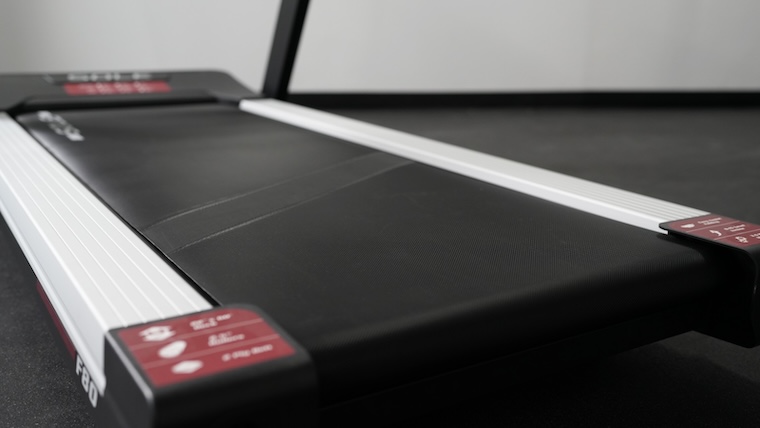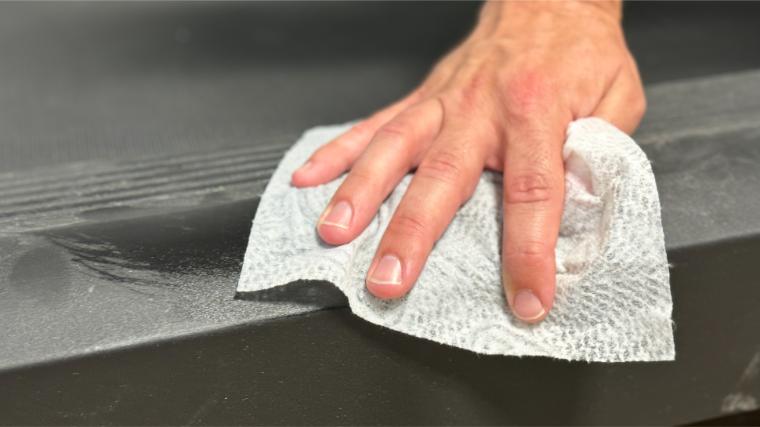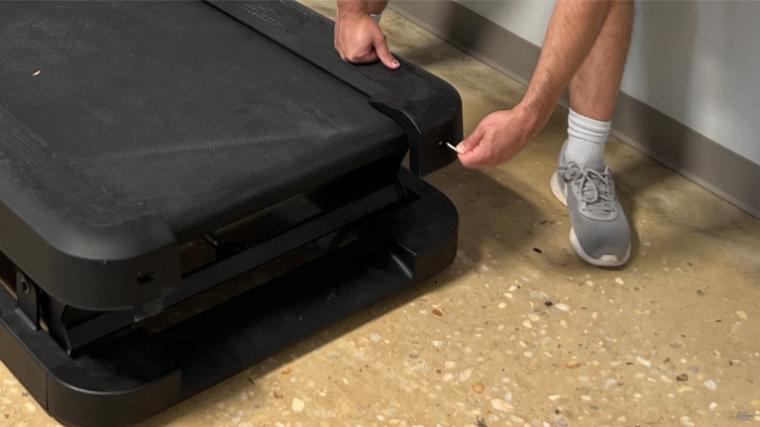Perhaps you’ve noticed that your home gym area has collected some soot-like buildup and you’re asking yourself, “Why is my treadmill leaving black dust?” There’s no need to fret. Even the best treadmills can have black dust begin to form along the belt, rollers, and surrounding flooring. Once you become aware of this rather unsightly development, though, it’s time to take action.
There are multiple reasons as to why your treadmill is leaving black dust, from excessive use to improper maintenance, low-quality treadmill belts, and more. In this guide, we’ll outline what this black dust actually is, identify some of the main culprits, explain how to resolve the issue, and provide some insight on how to ensure your training station is kept as clean and pristine as possible. Now, let’s get our hands dirty (pun intended) and hop right in.
What Is Black Dust?
It’s not uncommon for people to think their cardio machine is leaving carbon deposits across the flooring, but the black dust residue is actually a collection of small rubber particles. As your treadmill belt spins across the rollers and deck, the friction between the two can begin to wear at the belt’s surface. As the material becomes frayed and tattered, little pieces can begin to fall off, resulting in this buildup.

Given how your belt turns during training, you’re likely to find black dust collecting around the edges of your treadmill and the rear of the machine. These deposits can also grow across the rollers themselves, potentially leading to poor treadmill performance.
[Related: Treadmill Parts Explained]
Why Is My Treadmill Leaving Black Dust?
Amanda Capritto, our expert reviewer, states, “Having a treadmill at home may encourage a person to exercise more frequently, which is almost always a good thing.” That said, getting amped up for a session only to find mounds of black dust around your treadmill can kill your motivation, especially when you’re unsure of how it got there. Below are some of the main reasons your treadmill is shedding black dust and what you can do to resolve the issue.
Worn-Out Running Belt
One of the most common reasons your treadmill is spitting black dust is because your running belt is worn out. As with any piece of exercise equipment, parts and components can begin to wear over time, particularly if you’re using the machine on a regular basis. As you log mile after mile, your treadmill belt can begin to fray and weaken, resulting in the rubber chipping off.
If you notice that your running belt is worse for wear, a replacement is in order. Refer to your owner’s manual for the proper steps to removing the belt and information about which new belt model is compatible with your treadmill make. For more information on this process, be sure to read our guide on how to replace a treadmill belt.
Poor Fitness Equipment Maintenance
Be honest — have you been keeping up with cleaning your home gym equipment? If the answer is no, then this could be the reason for that sooty sensation around your tread. As dust and debris begins to build up across your treadmill’s belt and rollers, the accumulated particles can start to interact with the rubber components, turning them black. As they’re expelled from the machine through the natural belt revolutions, you can start to see the prominent pilings.

To resolve this, the best solution is to develop a regular cleaning schedule. If you’re unsure of how to clean a treadmill, fear not. It’s pretty easy. Wipe down your treadmill belt, console, side rails, and other plastic components after each workout to eliminate any grime or sweat. A weekly vacuuming around the belt and surrounding home gym flooring can also be beneficial. This can also be a good time to inspect your treadmill belt and frame, informing you of future treadmill maintenance to come.
Low-Quality Treadmill Belt
If you’re dealing with black dust around your machine but you’ve routinely cleaned it and the treadmill is only a few months old, it could be that your belt was just of a lower quality to begin with. Typically, this can happen with budget treadmills given that the components are cheaper than those found on sturdier commercial profiles. “Budget treadmills are likely to break down sooner than higher-end, more expensive models,” says Capritto. “It’s very true that you get what you pay for when it comes to home gym equipment.”

Thankfully, this can be an easy problem to fix by swapping your current running belt for a high-quality silhouette made from durable materials. Refer to your user manual or treadmill’s model number and look for a high-grade treadmill belt that fits your machine. You can think of this as upgrading your brakes on your car. Yes, you’ll pay a little more upfront, but the better components can lead to better performance and fewer headaches down the road.
Overused Treadmill Motor
While a majority of black dust problems can arise from friction across your treadmill belt, your machine’s drive motor can also be the culprit. This can be especially true if your tread is a little long in the tooth or gets used heavily throughout your training program.
Over time, your treadmill motor can begin to overheat, leading to particle breakdowns that resemble the rubbery black dust you’d see from your treadmill belt. To prevent this issue, it’s best to allow your treadmill to cool down properly in-between training sessions and keep the motor cage free of any excessive debris.
If you’ve used your treadmill’s motor past the point of saving, you could be in for more involved treadmill repair. This is why opting for a machine with a well-rounded warranty package is key from the start. “I recommend looking for 10 years on the frame, at least two years on parts, and at least one year for labor,” Capritto says.
How to Prevent Black Dust Buildup
Black dust can oftentimes be viewed as a product of time — your machine’s components will eventually wear out and begin to show signs of old age. However, there are still some preventative maintenance protocols you can adopt to ensure you’re not constantly dealing with this rubbery residue around your training space.
Regular Cleaning
Naturally, one of the best ways to prevent a messy buildup of black dust is to develop a regular cleaning routine. You can break down this upkeep into daily and weekly responsibilities.

After each treadmill workout, take a damp cloth or disinfecting wipe and swab your machine clean from the center console to the side rails, treadmill deck, and frame. This can help remove any sweat or grime while also picking up any built-up debris that’s developed in-between your sessions.
[Related: How to Clean Home Gym Equipment]
This can also be a good time to ensure your power cord is sitting properly with no tension between your tread and the outlet, and that the safety key connection point is clear of any blockers, like hair, dust, or other sticky substances.
On a weekly basis, we recommend taking your vacuum around the machine, cleaning any developed dust bunnies or debris that could have made its way around your training area. If you’re inclined, you can also lift the motor cage at the front of the machine and vacuum the internal components.
Proper Running Deck Lubrication
Keeping your treadmill belt slick and efficient with one of the best treadmill lubricants can go a long way in limiting the friction experienced between the rubber belt and rollers across the deck. We recommend lubricating your drive belt with a high-quality silicone lube every three to six months as part of your regular maintenance regimen.
Be mindful, though, that less lube can oftentimes be better than excessive lube. Read your user manual and lubricant instructions to ensure you’re not oversaturating the components which can lead to slippage and compromised treadmill performance.
Check the Tension and Belt Quality
When vacuuming around your treadmill or lubricating the belt, we also recommend checking the tension of the belt itself to ensure it’s not too taut across the rollers. A belt that’s too loose or too tight can lead to slippage issues and excessive friction. Lift at the center of the belt track on both sides and see whether you have enough slack — the belt should raise easily to 2 or 3 inches above the deck.

If you need to adjust the belt tension one way or another, gather your tools (typically an Allen wrench, screwdriver, and/or non-locking pliers), and refer to your owner’s manual for specific steps. You can also refer to our guide on how to adjust a treadmill belt for quick step-by-step insight on this quick procedure.
Final Word
Black dust, in any setting, can be an alarming cause for concern. Thankfully, this soot-like residue is often an indicator that your treadmill needs a quick tune-up or that you’ve been slacking when it comes to your home gym training hygiene — both of which are easily corrected with the right game plan.
When you start to notice black dust forming around your treadmill, a good troubleshooting protocol is to look at the main components of your machine, namely the belt, rollers, and motor cage. If you notice any excessive wear and tear, be sure to look through your user’s guide for proper part replacement steps. If a cleaning is in order (spoiler, it probably is), take a damp cloth and vacuum to the area to remove the buildup. With the right mindset and care instructions, you can easily eliminate any looming qualms you have with your tread’s black dust dilemma.
FAQs: Why Is My Treadmill Leaving Black Dust?
What is the black dust collecting around my treadmill?
More often than not, black dust around your treadmill is the result of friction between your treadmill belt and the rollers. The black particles are actually tiny specs of rubber that have worn off over time, indicating a low-quality running deck belt or excessive wear and tear across key areas.
How often do I need to clean my treadmill?
It’s good practice to clean your treadmill on a daily and weekly cadence. After each workout, take a damp cloth or disinfecting wipe to the console, side rails, and running deck to wipe up any excess sweat or dust. Vacuuming around your machine weekly can also go a long way in preventing any excess debris from clogging up the treadmill belt or motor cage.
What is the average lifespan of a treadmill?
Treadmills can commonly last up to 10 years, which is roughly the average warranty length. However, with proper maintenance and upkeep, you can likely have your machine for longer timeframes. It’s all a matter of what you put into your equipment.
How often should I lubricate my treadmill belt?
To prevent excessive friction and to ensure your machine is operating at peak levels, we recommend lubricating your treadmill belt periodically throughout the year. Every three to six months can be a good starting point depending on how often you use your treadmill in training.